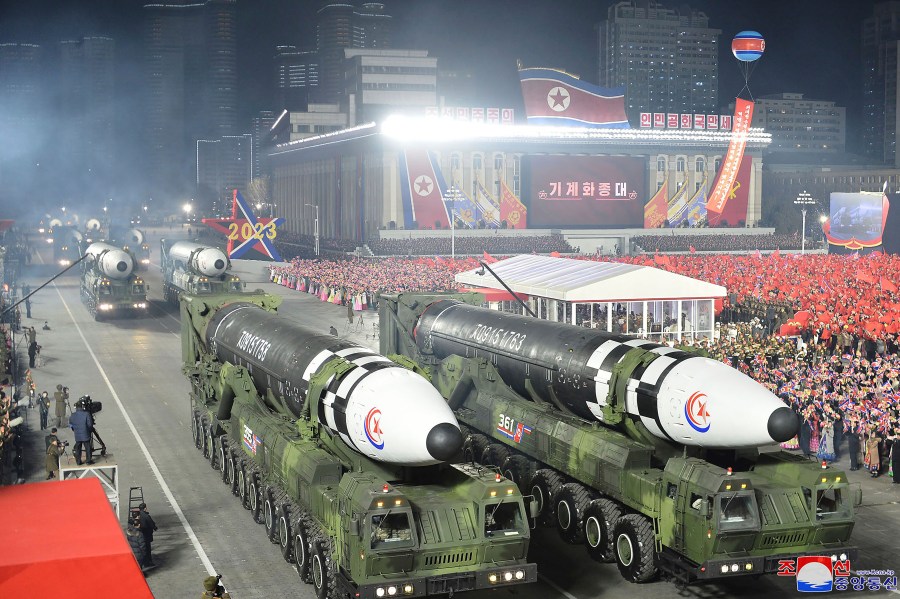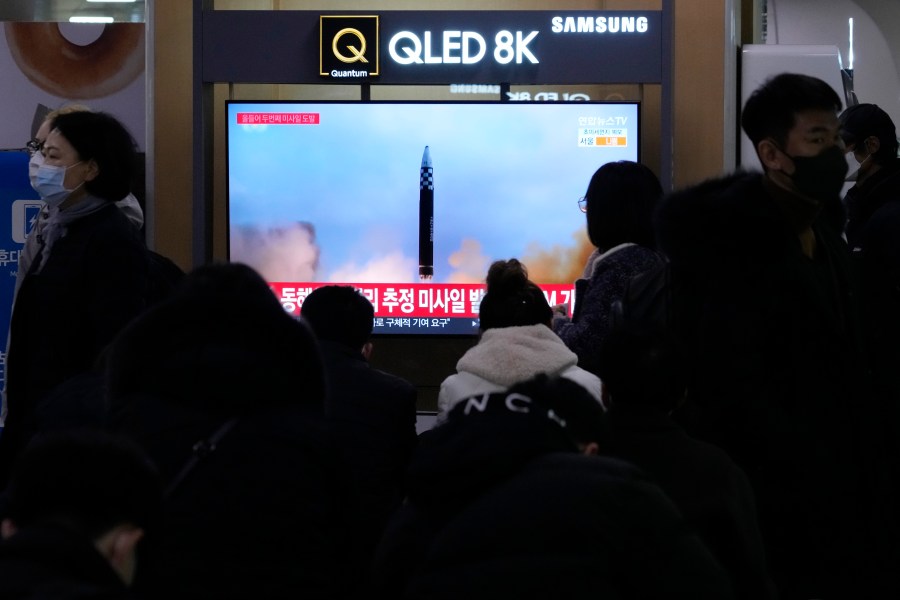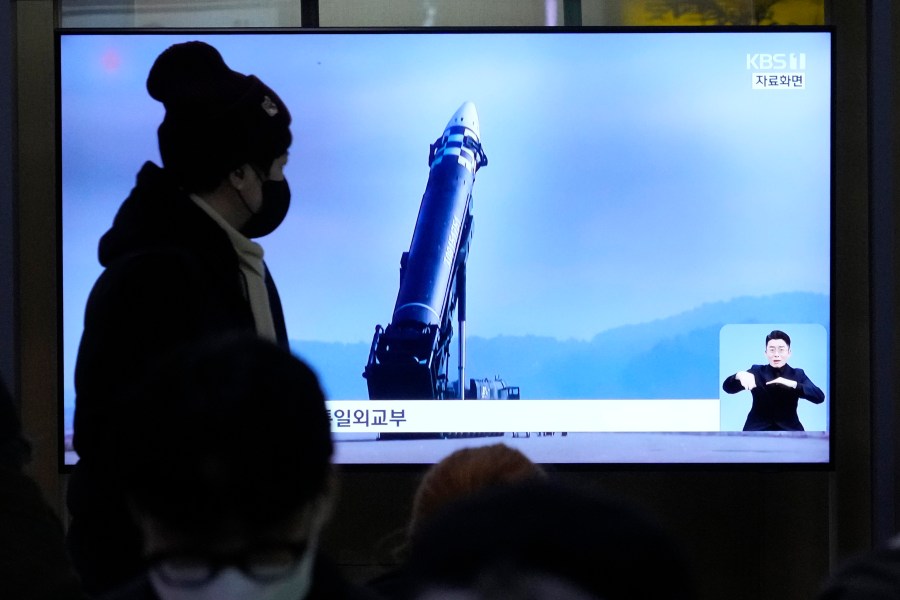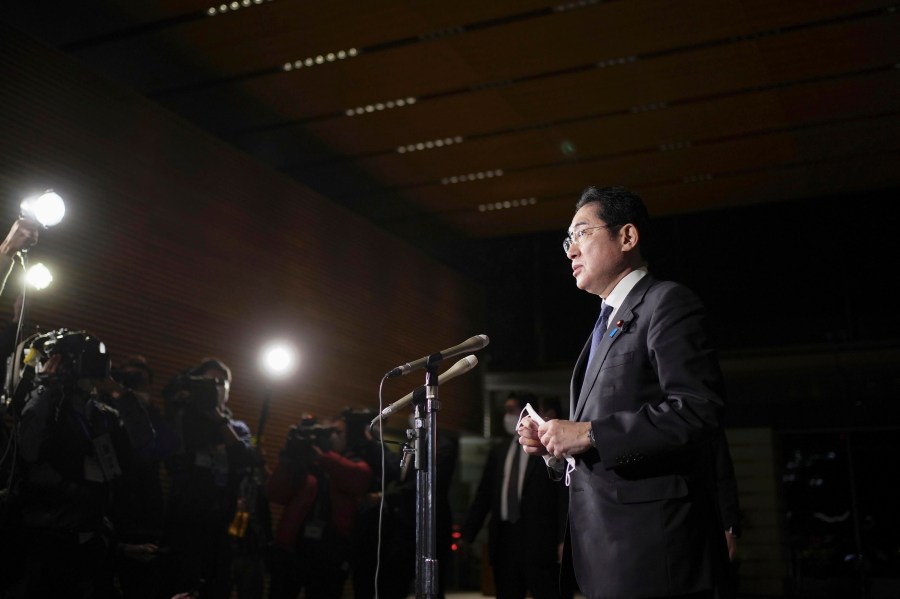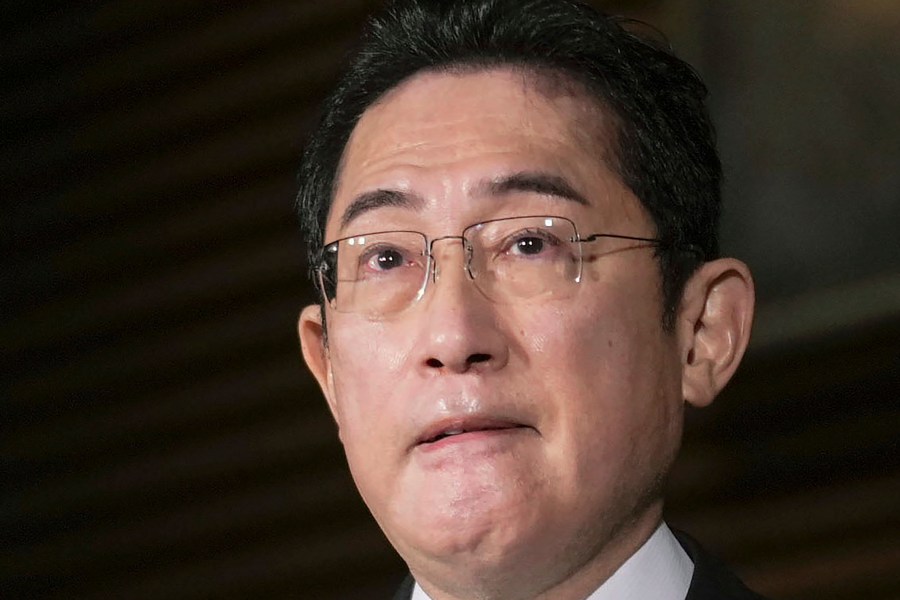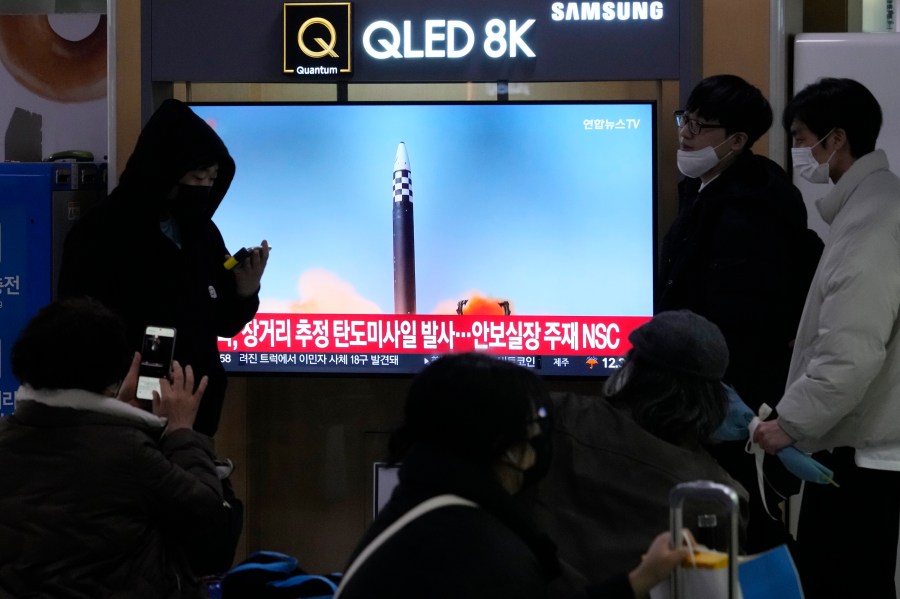US ‘strongly condemns’ North Korea’s long-range missile launch

A TV screen shows a file image of North Korea’s missile launch during a news program at the Seoul Railway Station in Seoul, South Korea, Saturday, Feb. 18. 2023. South Korea’s military said North Korea on Saturday fired one suspected long-range missile from its capital toward the sea, a day after it threatened to take strong measures against South Korea and the U.S. over their joint military exercises. (AP Photo/Ahn Young-joon)
SEOUL, South Korea (AP) — North Korea on Saturday fired a long-range missile from its capital into the sea off Japan, according to its neighbors, a day after it threatened to take strong measures against South Korea and the U.S. over their joint military exercises.
National Security Council spokesperson Adrienne Watson said in a statement that “the United States strongly condemns the Democratic People’s Republic of Korea’s (DPRK) Intercontinental ballistic missile test.”
While the statement said the missile test did not pose an immediate threat to U.S. personnel, territory or allies, the launch did “needlessly” increase tensions between the countries and “risks destabilizing the security situation in the region.”
“The United States will take all necessary measures to ensure the security of the American homeland and Republic of Korea and Japanese allies,” the statement concluded.
According to the South Korean and Japanese militaries, the missile was fired at a high angle, apparently to avoid reaching the neighbors’ territories, and traveled about 560 miles at a maximum altitude of 3,500 miles during an hour-long flight.
The details were similar to North Korea’s Hwasong-17 intercontinental ballistic missile test flight in November, which experts said demonstrated the potential to reach the U.S. mainland if fired on a normal trajectory.
Japanese government spokesperson Hirokazu Matsuno said no damage has been reported from the missile, which landed within Japan’s exclusive economic zone, about 125 miles west of Oshima island. Oshima lies off the western coast of the northernmost main island of Hokkaido.
North Korea’s Foreign Ministry on Friday threatened with “unprecedently” strong action against its rivals after South Korea announced a series of planned military exercises with the United States aimed at sharpening their response to the North’s growing threats.
The U.S. Indo-Pacific Command said the launch did not pose “an immediate threat to U.S. personnel, or territory, or to our allies,” but said it will continue to monitor the situation. It called on North Korea to “refrain from any further unlawful and destabilizing acts.”
The office of South Korean President Yoon Suk Yeol said his national security director, Kim Sung-han, presided over an emergency security meeting where members accused the North of escalating regional tensions. They denounced North Korea for accelerating its nuclear arms development despite signs of worsening economic problems and food insecurity, saying such actions would bring only tougher international sanctions.
Japanese Prime Minister Fumio Kishida said Tokyo was closely communicating with Washington and Seoul over the launch, which he called “an act of violence that escalates provocation toward the international order.”
The launch was North Korea’s first since Jan. 1, when it test-fired a short-range weapon. It followed a massive military parade in Pyongyang last week, where troops rolled out more than a dozen ICBMs as leader Kim Jong Un watched in delight from a balcony.
The unprecedented number of missiles underscored a continuation of the expansion of his country’s military capabilities despite limited resources while negotiations with Washington remain stalemated.
Those missiles included a new system experts say is possibly linked to the North’s stated desire to acquire a solid-fuel ICBM. North Korea’s existing ICBMs, including Hwasong-17s, use liquid propellants that require pre-launch injections and cannot remain fueled for prolonged periods. A solid-fuel alternative would take less time to prepare and is easier to move around on vehicles, providing less opportunity to be spotted.
It wasn’t immediately clear whether Saturday’s launch involved a solid-fuel system.
“North Korean missile firings are often tests of technologies under development, and it will be notable if Pyongyang claims progress with a long-range solid-fuel missile,” said Leif-Eric Easley, a professor of international studies at Ewha Womans University in Seoul. “The Kim regime may also tout this launch as a response to U.S. defense cooperation with South Korea and sanctions diplomacy at the United Nations.”
North Korea is coming off a record year in weapons demonstrations with more than 70 ballistic missiles fired, including those with the potential to reach the U.S. mainland. The North also conducted a slew of launches it described as simulated nuclear attacks against South Korean and U.S. targets in response to the allies’ resumption of a large-scale joint military exercise that had been downsized for years.
North Korea’s missile tests have been punctuated by threats of preemptive nuclear attacks against South Korea or the United States over what it perceives as a broad range of scenarios that put its leadership under threat.
Kim doubled down on his nuclear push entering 2023, calling for an “exponential increase” in the country’s nuclear warheads, mass production of battlefield tactical nuclear weapons targeting “enemy” South Korea and the development of more advanced ICBMs.
The North Korean statement on Friday accused Washington and Seoul of planning more than 20 rounds of military drills this year, including large-scale field exercises, and described its rivals as “the arch-criminals deliberately disrupting regional peace and stability.”
South Korea’s Defense Ministry officials told lawmakers earlier that Seoul and Washington will hold an annual computer-simulated combined training in mid-March. The 11-day training will reflect North Korea’s nuclear threats, as well as unspecified lessons from the Russia-Ukraine war, according to Heo Tae-keun, South Korea’s deputy minister of national defense policy. Heo said the countries will also conduct joint field exercises in mid-March that would be bigger than those held in the past few years.
South Korea and the U.S. will also hold a one-day tabletop exercise next week at the Pentagon to sharpen a response to a potential use of nuclear weapons by North Korea.
North Korea has traditionally described U.S.-South Korea military exercises as rehearsals for a potential invasion, while the allies insist that their drills are defensive in nature.
The United States and South Korea had downsized or canceled some of their major drills in recent years, first to support the former Trump administration’s diplomatic efforts with Pyongyang and then because of COVID-19. But North Korea’s growing nuclear threats have raised the urgency for South Korea and Japan to strengthen their defense postures in line with their alliances with the United States.
South Korea has been seeking reassurances that the United States will swiftly and decisively use its nuclear capabilities to protect its ally in face of a North Korean nuclear attack. In expanding its military exercises with South Korea, the United States has also expressed commitment to increase its deployment of strategic military assets like fighter jets and aircraft carriers to the Korean Peninsula in a show of strength.
In December, Japan made a major break from its strictly self-defense-only post-World War II principle, adopting a new national security strategy that includes preemptive strikes and cruise missiles to counter growing threats from North Korea, China and Russia.
NewsNation’s Devan Marham contributed to this report.





